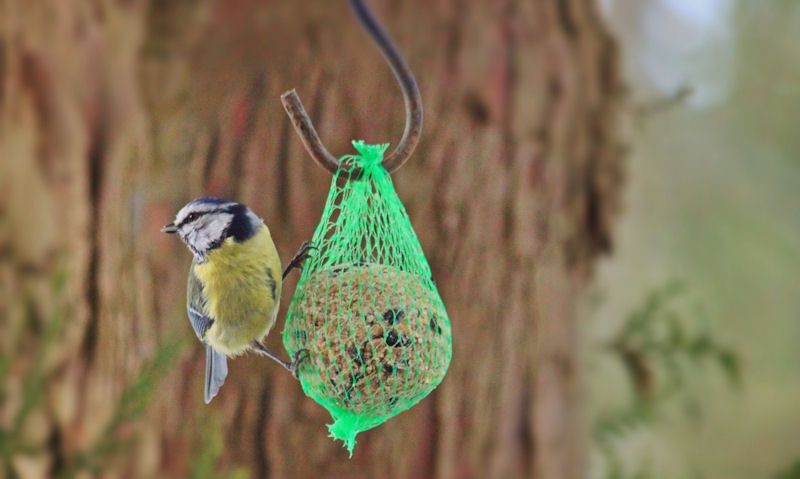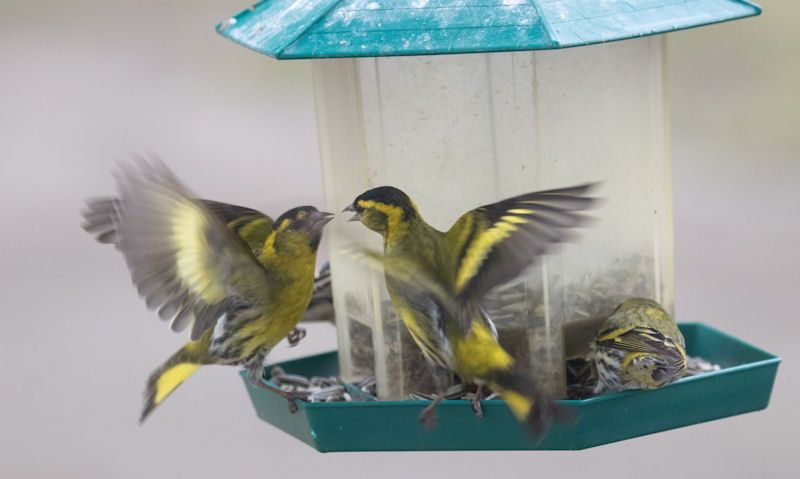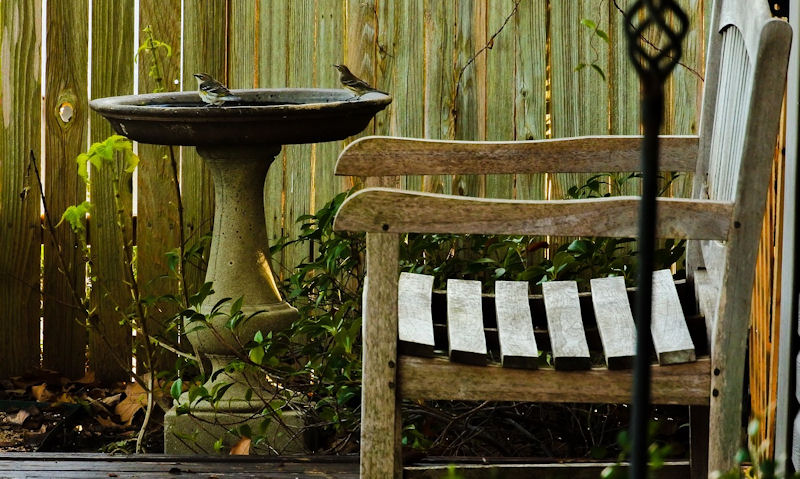Best place to hang fat balls
Finding the best place to hang up fat balls should not jeopardise both the feed or the health of the birds.
What you should first consider is location; hang up fat balls in the shade, high up off the ground well using natural coverage from the hedgerows or trees. Depending on if you're using fat balls in netting or a feeder, they have there limits, well the netting kind can be hung up anywhere.
It doesn't have to be complicated hanging fat balls for wild birds, though finding the best place possible will have its benefits.
Amongst them it should help you entice birds to feed not only in your garden, but feeding on the fat balls especially.
If using a feeder for fat balls, then you're only limited to use of the bird feeding station or wall bracket, or more inventive structures around the garden.
That will be helped with use of an S bracket to help the feeder be hung up in the most oddest places; washing line, gazebo, flower basket or pergola.
Though you might want to seriously consider hanging the fat balls in the netting or hanging off the wooden bird table, just to extend the feeding options in one location.
Consider keeping fat balls hung up in the shaded area in your garden, keeping it off the ground well out of reach of squirrels.
Best place to hang fat balls in netting or feeders is within natural cover, so a branch just on the inside of the hedgerow will do, and so will a tree branch.
Wild birds need natural coverage nearby, so make it happen by setting up in the bracket with potted plants, or site the bird feeding station near plants, hedges or bushes.
In the shade
When taking in our advice its essential you always consider the location before anything else, as a matter of keeping the fat balls in good condition.
That's making sure the fat balls - whether in feeders or netting - are hung up in an area that is out of direct sunlight.
While fat balls are not likely to melt or drip, the lard that bonds the ingredients requires a high melting point, and sunshine is still unlikely to cause an issue.
Where you will get in trouble is the condition of the fat balls will become inedible for wild birds as it quickly germinates with bacteria forming under the heat.
Its quite possible to hang up fat balls in the garden with little sunshine for up to a few days while it still keeps at its best.
However, sunshine in the spring its likely to reduce this timing to only a couple of day, well the heat in the summer will cause it to expire within a day or so.
One way around this is to hang up fat balls in the shade only, this way its always out of sunlight, though remember the heat can still speed up the rotting process.
Shaded areas can be one side of the house, a single side of the tree, or the hedgerows that has the shaded area for most, or the whole day.
High off the ground
If you've found the spot to keep the fat balls hanging up in a way that positions them out of the sun, another issue to deal with is how high off the ground should fat balls hang.
There's no hard or fast rules how high bird feed should hang, but it should be high enough as to be out of reach of pets, predators or possibly children.
When hanging up in a blooming hedgerow or plantation, lower down to the ground should not be an issue as the coverage should keep it discreet.
Not so though as it hides away from wild birds well preventing them from ever seeing it.
To guarantee a good height off the ground, hang fat balls off the highest point off the bird feeding station.
If you feed birds fat balls from mesh feeders, not a problem, they can be sited lower.
However, if choosing to feed wild birds from the netting, you'll have to locate it high as possible as to stop nuisance large bird or even squirrels reaching up to them.
Fat ball in nets vs. feeders
One thing to consider how you present fat balls to wild birds is do you go for the more convenient netting, or the fat ball feeders.
Opting for the netting will make it quick and easy to find a place to hang up fat balls, as the netting makes for clinging onto plants or branches a breeze.
Going for the fat ball feeder option, that should only be if you have the feeder already.
If you don't own a bird feeder for fat balls that might not be necessary, all you need is the netting as it can be hung anywhere... as we've mentioned.
With fat ball feeders you're limited to the best place to hang fat balls, in fact it might just be the bird feeding station, wall bracket or tree branch.
So if its was up to us, we would say the fat balls in netting would be best.
But there's a problem, the plastic used for the netting is not good for the environment, nor is it good for your garden if left out or blown away.
So for that reason we would say forget the netting and invest in a specialty fat ball feeder.
Furthermore, you may not want to hang the fat balls up at all, while choosing to use loose balls to pile up in the bird feeding tray, on a wall or top of a fence post.
Now that we've got the basics done with, let's take a look at the best places to hang fat balls in netting or feeders.
In the hedgerows
First and foremost, hedges that run along the one or both sides of your garden are quite possibly the best places to hang fat balls.
If you consider wild birds need nearby coverage while eating at the bird feeders, what better way than to locate the feed in the hedges for natual cover.
It might not be for all of you, but its quite possible the safest way to feed fat balls to birds.
If you have a single or short hedge with additional plantation, this will work just as well, but so will any blooming hedges or plants really.
All that needs to be done first is locating a thick branch that grows within the hedgerow.
You can then do one of two things; insert the fat balls on to the branch well it will in tern pull the balls back into the hedge.
And secondly, it might be possible to actually pull out the said branch, well making sure it remains sticking out the hole time.
That way it makes for a natural bracket for whenever you want to hang fat balls up, and you get to see the birds using it.
On the other hand, this method will only work well using fat balls in netting, not so much if you need to hang up the feeder for fat balls as it won't allow for much eating space.
Off the tree branch
After the hedgerow, a shaded tree branch with a clear line of sight would make for the ideal placement for hanging fat balls.
In fact we would put it level with a blooming hedgerow, only the opportunity to use a branch off a tree it not for most gardens, where more people have hedges.
Where you should site the fat balls on the tree should be on the branches that are located further down the tree, just before they stop where only the tree trunk remains.
That way the birds will use the lack of coverage near to the bottom as a means to escape, well providing a clear line of sight for coming and going.
Not all tree's can be describe like this, in fact all types of trees may allow you to hang up fat balls in areas not suggested, that includes...
- Hanging up fat balls on a branch that it on the outside of the tree, way beyond the natural coverage
- Open sided tree with no coverage at all, thus exposing the fat balls to the one side, well offering coverage on the other side of the tree
When using a tree that has lots of leaf cover, you may want to pick your spot while taking into consideration if you want to see birds feeding or not.
If you don't then pick a branch that ticks all the boxes we've mentioned previously.
Well if you do want to watch birds coming and going to bird on the fat balls in the tree, make it the side where there less leaf coverage, or alteast an area with a gap to view.
Trees not only offer natural protection from the elements, they also can offer lots of shade, so try to take advantage of this by hanging the fat balls with care.
Above the hanging flower pot
If you'd allow us to be a bit more inventive, have you ever considered the hanging flower pot to double up as a feeding area for your fat balls.
We would only say this method will only work with a bunch of fat balls in the netting, as distance from flower pot to hook on the bracket won't allow for larger feeders.
And by that we mean any feeder really, as the length and width won't allow for it to hang properly, well making it hard for the wildlife to feed.
So what exactly are we talking about by hanging fat balls inside a flower pot?
Simply put, you know the flower basket that hangs up - usually with chain links - to the hook on the corresponding bracket, well this hook should have room for a fat ball netting.
Not much room is available so you'd should probably forget about feeders if you do have a small one, just reserve the hook for the chains to fix to, well pinching the netting on too.
What that will look is quite interesting, and very beautiful we might add...
Well the pot has quite possibly blooming flowers or plants overflowing, the basket the pot is inserted in, would be hanging off chains to the wall or fence bracket above.
Dead centre between hanging off four chains that hook over the bracket hoop are the fat balls dangling down.
Bird feeding station
If it all comes down to it and you're are desperate for a simple place to hang fat balls, easy solution to this is the bird feeding station - that's if you have one.
If not, there's no need to invest heavily in a new bird feeding system on a pole, its quite possible to buy a simple bird pole with a single bracket for hanging.
It can be embedded into the lawn - which is a cheap option - all the while a universal counter-weight base would be a good option if you're unable to impale a pole in the ground - due to lack of lawn/turf - with just a patio available to you.
Huge advantages come with bird feeding station; amongst them they're mobile.
Meaning you can upend the pole and move it around the garden until the location gets the most interest from birds.
It would also be possible to move the feeding station around the garden as the sun moves across the sky, thus keeping the hanging fat balls in the shade.
If anything, at least this option will allow you to setup a feeding area for birds that will allow for you to watch on as birds come and go to feed.
Hanging off fat balls from the bracket from the feeding system will also allow you to either use the netting, or go with a specialty feeder for fat balls, which we like best.
If you plan to locate the station outside your window to view birds feeding, make it so the pole is tall enough as to give the height it needs to view through the window.
To summarise
When supplying fat balls to wild birds strongly consider the natural coverage of trees or hedgerows, and all related plantation found in a garden.
Birds like to duck and dive for cover every once in a while, so a nearby hiding place such as hedgerows or trees is just the thing.
It may not be possible for you all, so at least try to piggyback off your neighbours plants or a tree outside you garden boundary.
All while making sure there's lots of shade to help protect the fat balls from rotting to quickly, and they would last longer if placed in a shaded, cool area.
If you want the best place to hang up fat balls, then make use of a thick branch inside a hedgerow with lots of shade, but still with a gap for you to watch as they eat.
When using a tree make it a low baring branch as to allow birds a clear line of sight with a flight path with no obstructions such as additional branches.
If all that is not doable, then its still possible to make do with a bird feeding station, or a wall bracket for hanging bird feeders.


